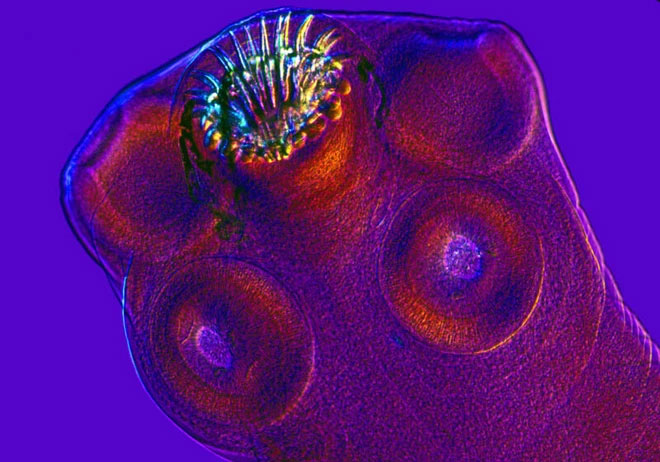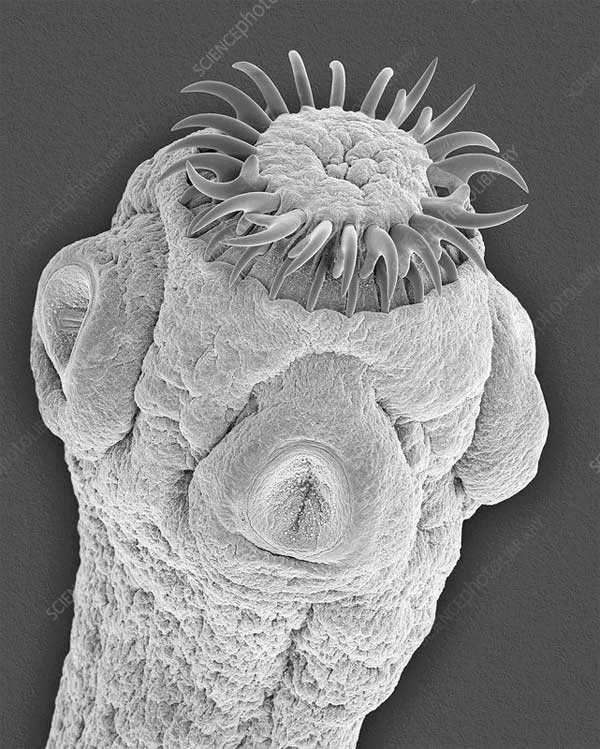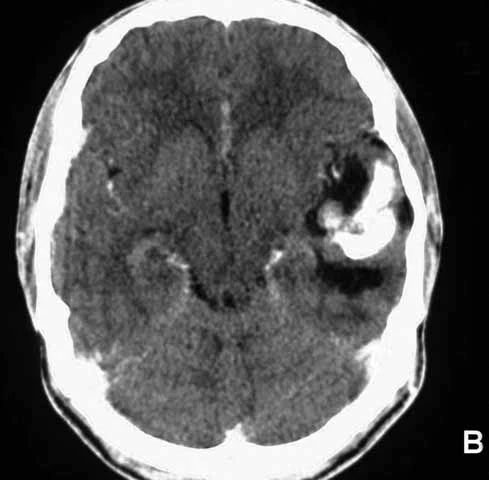That night’s sleep was not as peaceful as usual when a 38-year-old man with no medical history experienced a seizure at 4 AM. Discovered by his wife lying on the floor, shaking uncontrollably and “talking nonsense,” he was quickly rushed to Massachusetts General Hospital.
At the hospital, doctors witnessed the man losing consciousness, with all his muscles contracting. Surprised by the unusual symptoms of someone who was considered healthy, the doctors conducted a series of tests while asking the family about recent events.

Head of a pork tapeworm.
On almost every account, the 38-year-old man from Massachusetts was healthy. He had no history of seizures and had never exhibited symptoms of shortness of breath, arrhythmia, or any diseases related to digestion, reproduction, or the nervous system. He was not intoxicated at the time of the seizure and did not use any medications. The man occasionally consumed alcohol but had never smoked.
No evidence indicated a cause for the seizure: before falling ill, he had spent the entire day playing with his child and had dinner with family without any significant changes to his routine. One noteworthy point in his history was that he had migrated from a remote area in Guatemala to Boston about 20 years ago.
When doctors performed a CT scan on the patient’s head, they narrowed down the potential causes of the illness. The CT images revealed three calcified lesions in the patient’s brain, and the doctors diagnosed him with neurocysticercosis. In other words, the larval cysts of the pork tapeworm had found their way to this man’s brain many years ago and lay dormant.
This rare case has become a new case study in medicine and has been published in The New England Journal of Medicine.

Tapeworm living in the intestines of mammals.
The Journey from the Intestines to the Brain
The study of neurocysticercosis is not for the faint-hearted, as both the infection process and the disease’s consequences are horrifying. The pork tapeworm Taenia solium typically resides in the intestines of humans and can grow from 2 to 8 meters long. They spread by excreting their eggs in the feces of the host, and if this feces containing tapeworm eggs finds its way into the intestines of pigs, the animal becomes a new host for the parasite.
The acids in the pig’s stomach will erode the outer coating of the eggs and cause the larvae to hatch. The larvae can penetrate through the pig’s intestines to enter the bloodstream, then hide within the pig’s muscle fibers, waiting for the right moment. During this stage, the tapeworm does not affect the animal’s normal life.
If a person consumes undercooked pork containing cysts, the life cycle of the parasite begins anew. Inside the human intestines, the tapeworm hatches from the eggs, attaches itself to the intestinal wall, and absorbs nutrients from the warm abdominal cavity. They develop into tapeworms several meters long, simultaneously excreting eggs in the host’s feces. The life cycle of the tapeworm returns to the starting point.

Cyst of a tapeworm in pork.
However, when a person ingests tapeworm eggs, often occurring when a hand contaminated with feces prepares food, things become complicated. Similar to pigs, the tapeworm eggs will hatch in the human intestines, and the cysts will find their way into the human muscles, but they can also reach sensitive areas like the eyes and brain.
The tapeworm has reached its end, but the health issues in humans are just beginning.
Tapeworms in the Brain
In the human brain, the cysts undergo four stages.
First, they remain dormant. Because the immune system hardly reacts to foreign objects, the body shows no clear symptoms. This stage can last for many years, but as the cysts gradually deteriorate, the fluid inside the cysts spilling out will trigger an immediate immune response to the threat of parasitic infection.
The cysts break down, forming a small tumor in the brain. Eventually, the tumor calcifies into a granuloma. In older literature, there have been many cases of patients experiencing seizures when the calcification process entered its final stage.

CT scan helps locate a tumor in the brain.
Neurocysticercosis is a common parasitic infection in humans that can cause headaches, confusion, balance issues, seizures, and even death. Epilepsy is also one of the manifestations of neurocysticercosis. In many regions of Asia and Central America, the tapeworm can cause widespread outbreaks.
Based on the medical history of the 38-year-old man, doctors believe he contracted the tapeworm while living in a remote area of Guatemala. It is highly likely that neurocysticercosis caused the seizure that night.
After arriving at the hospital, the man was treated with various antiepileptic medications, placed on a ventilator, and then transferred to the neurology department. Once stabilized, the doctors prescribed antiparasitic medication and anti-inflammatory drugs alongside the antiepileptic medications. After 5 days of treatment, the man was discharged without any further symptoms.
However, doctors continued to monitor him for the next three years. Months after treatment, CT scans showed that the largest granuloma had decreased in size. He also no longer experienced seizures, although he continued to take antiepileptic medication regularly. Since the granuloma is unlikely to completely disappear in the near future, it remains unclear how long he will need to continue taking medication.


















































